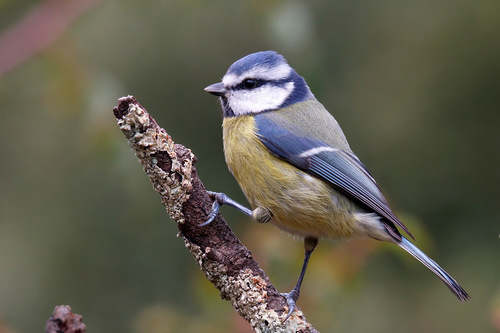
Eurasian Blue Tit
The Eurasian Blue Tit (Cyanistes caeruleus) is a small, vibrant passerine bird widely recognized for its striking blue and yellow plumage. It is a common sight in gardens, woodlands, and parks across Europe and parts of the Middle East. This adaptable bird plays a crucial role in controlling insect populations, particularly caterpillars, making it beneficial to both natural ecosystems and human agriculture. While not holding any major cultural significance comparable to some other bird species, the Blue Tit's cheerful presence and readily observable behavior make it a popular subject for birdwatchers and a symbol of the changing seasons in many European countries.
10.5-12 cm
Length
17.5-20 cm
Wingspan
Least Concern
Conservation Status
Distribution
The Eurasian Blue Tit is found throughout Europe, extending eastward into parts of the Middle East and western Russia. Its range includes the British Isles, most of mainland Europe, and parts of Turkey, Iran, and the Caucasus region. It is largely non-migratory, though some northern populations may move south for the winter. Altitudinally, it can be found from sea level up to subalpine zones.
Lifespan
The average lifespan in the wild is around 2-3 years, although some individuals can live longer. In captivity with no predators, they can live up to 10 years.
Eurasian Blue Tit's Habitat
Habitat Types
Deciduous woodlands, Mixed forests, Parks, Gardens, Hedgerows
Climate Zones
Temperate, Mediterranean
Adaptations
Blue Tits are highly adaptable to a variety of wooded habitats. Their small size and agility allow them to forage effectively in dense foliage. They have strong claws for gripping branches and are adept at hanging upside down to access food.
Variations
Several subspecies of the Eurasian Blue Tit are recognized, differing slightly in plumage coloration and size. For example, populations in North Africa tend to have a darker blue cap and a more extensive black band across the eye.
Appearance
Breeding Plumage
Plumage is generally similar year-round, but breeding birds may have slightly brighter colors.
Seasonal Feather Changes
Minimal seasonal variation, molting occurs after the breeding season.
Sex Based Plumage Differences
Males generally have a slightly brighter blue crown than females, though this difference can be subtle. Juveniles have a yellowish wash to their plumage and a duller blue cap.
Notable Features
Bright blue cap and wings, Yellow breast and belly, Black eye stripe, White cheeks, Small, black bib
Diet and Feeding
Primary Foods
Insects, Caterpillars, Spiders, Seeds, Berries
Foraging Behavior
Blue Tits are active foragers, flitting through branches and foliage in search of food. They are acrobatic, often hanging upside down to reach insects and spiders. They also readily visit bird feeders, especially in winter.
Specializations
Their small, pointed beaks are well-suited for picking insects from crevices and leaves. They also have strong feet for clinging to branches.
Seasonal Diet Variations
During the breeding season, their diet consists mainly of insects and caterpillars, which are essential for feeding their young. In winter, they shift to a more seed and berry-based diet when insects are scarce.
Behavior
Social Structure
Blue Tits are generally sociable, forming small flocks outside of the breeding season. During the breeding season, they become more territorial.
Communication
Variety of calls and songs, Churring alarm calls, High-pitched 'see-see-see' calls, Complex songs used for territory defense and mate attraction
Migration
Most populations are resident, but some northern populations may undertake short-distance migrations in response to harsh winter conditions.
Territorial or Group Behaviors
During the breeding season, pairs defend a small territory around their nest site. Outside of the breeding season, they may form mixed-species flocks with other tits and small birds.
Conservation
Threats
Habitat loss (deforestation and urbanization), Pesticide use (reducing insect prey), Competition with invasive species (e.g., non-native birds), Predation (by cats, squirrels, and birds of prey)
Protection Programs
General wildlife protection laws, Provision of nest boxes, Habitat restoration projects
Local National Laws
Protected under various national and international wildlife laws, such as the Wildlife and Countryside Act 1981 in the UK.
Population Trend
Stable
Population Estimates
The global population is estimated to be very large, with millions of breeding pairs across its range.
Interesting Facts
Blue Tits are known for their intelligence and problem-solving abilities.
They have been observed to learn how to open milk bottles to access the cream.
The blue color in their feathers is structural, not pigment-based.
Tiny structures in the feathers scatter light, creating the blue appearance.
They are important predators of oak gall wasps.
By consuming these wasps, they help to protect oak trees.
Faqs about Eurasian Blue Tit
What do Blue Tits eat?
They eat a variety of insects, caterpillars, spiders, seeds, and berries. Their diet changes with the seasons.
Where do Blue Tits nest?
They nest in cavities, such as holes in trees or nest boxes. They line their nests with soft materials like moss, grass, and feathers.
Are Blue Tits migratory?
Most populations are resident, but some northern populations may move short distances in winter.
How long do Blue Tits live?
The average lifespan in the wild is 2-3 years.
Copyright @ Nature Style Limited. All Rights Reserved.
 English
English